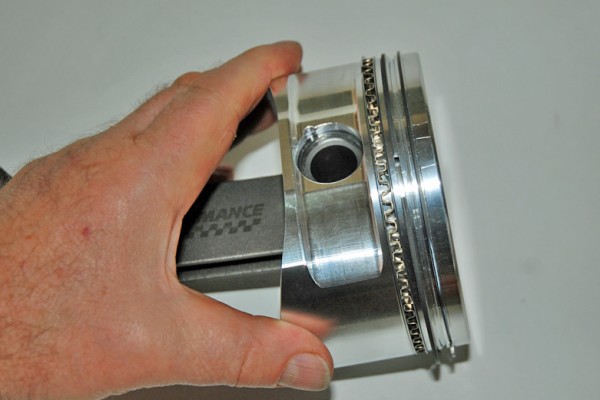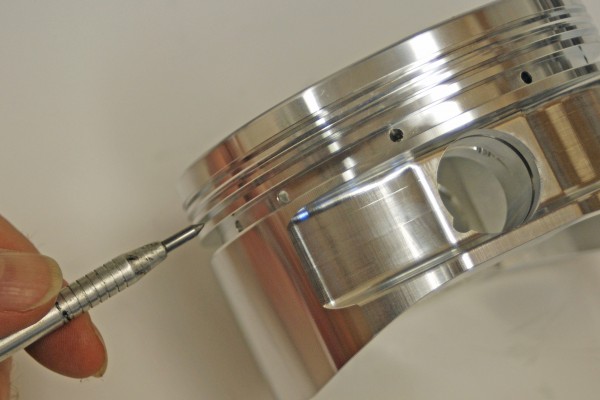When it comes to pistons, the most common arrangement you’ll encounter makes use of three piston rings — compression, second, and oil. Today, we’re turning our focus to the areas of the piston most associated with the rings: the ring lands and grooves.
Piston ring lands are the areas of the piston between the piston rings. Most ring lands are round, although there have been some exceptions over the years. The overall diameter of the ring land in a common piston is smaller than the overall diameter of the piston, and in many cases, there is a small vertical taper. The reason for this size differential is that once the piston reaches top dead center, it rocks in the bore. If the piston ring land were the same diameter as the skirt, the rings would be required to handle the thrust load. The job of handling thrust loads is best left up to the piston skirt.
Something else you’ll hear about in relation to ring lands is “tilt.” Some (but not all) manufacturers machine the actual ring grooves with a positive “tilt.” This tilts the ring package upwards by a very small amount to help with ring seating. We should also point out that the tilt is included in all of the ring grooves — top, second, and oil. (FYI, some pistons of questionable quality can actually incorporate a negative tilt. This will hurt performance more than it will help.)
The locations of the ring lands and grooves in the piston are dictated by the compression height of the piston, the size and depth of the valve notches, and the overall dimensions of the ring package. Most Detroit-built engines have the top ring from .300 to .400 inches down from the deck surface. In an endurance racing application, the top ring is typically .125 to .150 inches down. And in heavily modified race engines, top ring location can vary from .060 to .100 inches down from the deck. There are good reasons for moving the top ring closer to the piston deck. As the amount of “dead air” space between the top ring land and piston deck is reduced, the amount of trapped combustion gasses is also reduced. The combustion process is cleaned up considerably and power is increased as the rings are moved upward.
While pondering the location of the rings, we also need to consider how much material is found between the rings. While the location of the second ring isn’t as critical as the distance from the deck down to the top ring, it is still important. The second ring doesn’t encounter temperatures anywhere close to those witnessed by the top ring, but the ring land area between the top two rings must also support the combustion pressure exerted upon the top ring. Because of this, the width of the first land area is usually between .150 and .180-inch in a high performance piston and often much larger in a stock application. As far as the land area between the second and third ring is concerned, many high performance and race pistons incorporate a width of between .070- and .125-inch. This is narrower than the first ring land, but combustion pressures aren’t present (at least they shouldn’t be) and overall temperatures these rings see are much lower.
Depending on the manufacturer, some ring lands have special designs. For example, some pistons have “stepped” lands. This means the land area between the top and second rings is slightly smaller in diameter when compared to the area between the second and oil rings. Other high performance and race pistons are manufactured with a groove milled into the land area between the top and second ring. This is called an “accumulator groove,” and it’s designed to reduce pressure buildup between the pairs of rings and maximize ring seal.
When examining piston grooves, you’ll find a couple of different types of oil drain back holes are regularly used: drilled and slotted. Drilled drain back holes make for a stronger piston in most cases, but they do allow more heat to enter the skirt area. The vast majority of race pistons are constructed with drilled drain back holes as slotted drain back holes can allow more flex in the piston skirt.
Another consideration is the actual ring clearance within the groove. To achieve proper ring clearance, especially where the compression ring is concerned, the ring grooves must be smooth. This is because the ring drops to the bottom of the groove during the compression stroke, eventually sealing against the machined surface. During the power stroke, the piston moves down in the bore, causing the ring to up in the groove and seal against the top of the machined surface. A poor finish in the groove will not allow the ring to seal tightly and pressure will leak past the backside of the ring. The result will be excessive heat discoloration or carbon buildup in the land area between the top and second rings.
Production street engines often have clearances between .002 and .004 inches, but something like a race piston should never exceed a .002-inch vertical clearance. More vertical clearance will cause the ring to leak; less vertical clearance may cause the ring to seize within the groove. Keep in mind that a ring that can’t turn freely in the groove will not clean carbon out of the groove and will not be free to expand when combustion pressures enter the groove.
Piston machining plays a major role when it comes ring performance. Some of the piston machining capability out there might surprise you. CP-Carrillo has used highly accurate inspection equipment to determine how machining methods had an effect upon the flatness of things such as the ring groove. This research led them to ring machining tolerances that are measured to one millionth of an inch. This means the ring grooves are absolutely flat for superior ring seal and increased horsepower.
Should the piston have tight vertical clearances, the ring back clearance figures become even more critical. Gas pressure enters the area behind the ring during combustion and forces the ring outward against the cylinder wall. If there is too much back clearance, then it takes too long for the pressure to build and the ring isn’t forced outward. A smaller back clearance will increase the speed and the force at which the ring will exert pressure against the cylinder wall. Typically, a production engine piston will have as much as .040 to .050 inches of back clearance. In a race or high performance engine, the back clearance figure can be reduced to as little as .020 inches. There is a limit to this, however, as the back clearance can’t be so small that the ring protrudes past the ring land.
The one exception to the vertical clearance rule is when pistons come with gas ports. When gas ports are included, there are usually twelve to sixteen .040- to .060-inch holes drilled vertically through the piston deck. They intersect with the backside of the compression ring groove and supply combustion pressure directly to the backside of the ring. This pressure means the ring vertical clearance can be decreased to significantly reduce ring flutter without effecting the seal. Of course, gas ports are only suitable for use in engine combinations that see frequent teardowns.
When all is said and done, the ring lands and grooves in a piston are far more sophisticated than you might think. Modern machining and measuring capabilities have made pistons and rings the most accurate in history. Best of all, this piston technology is readily available at companies like Summit Racing.











but something like a race piston should never exceed a .002-inch vertical clearance.
I think your wrong here !!!
Dragsters used to run .010-.012 ” with Teflon buttons on the skirts
When we talk ‘rule of thumb’ or minimum back space Re: Oil ring pack and read 0.015 thou is this assembled (so 30 thou overall) or 0.015 minimum overall (so .0075 thou) per side ‘as it were’ ?? assembled…
I read .015 everywhere but I dont read overall or do we split that figure in two ??
Where can I get some ring groove shim stock to reduce the back clearance? Googled it but no results. Thanks
Do you mean oil ring spacers? You can find them here.